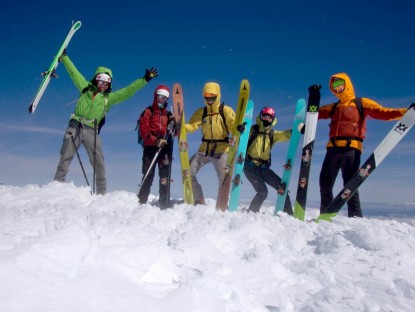Dynafit Blacklight Pro Review
Our Verdict
Our Analysis and Test Results
The Blacklight Pro is Dynafit's lightweight ski for high, steep, far, and firm. These are spring volcano skis and skis for skiing bulletproof windboard well above the trees. They are also well-suited to inbounds “fitness uphilling”. Pairing these skis with suitable boots and bindings will be important. Think light as you do so.
Weight
One Dynafit Blacklight Pro weighs just under one kilogram. The “kilogram threshold” is relevant in both skis and boots. Skis and boots less than 1000g are definitely well into the ultra lightweight category.
Few skis we test are lighter than the Blacklight Pro. There are some out there that are lighter, but the market just isn't leaning in that direction currently. Our test team is selective about just when we will take out skis this light. We do it to go far, to go high, and when the pace is quick.
Firm Snow
Some amazing backcountry skiing takes place on firm snow. You might not reach that conclusion looking in magazines and mass-market ski movies. But facts are facts: big, beautiful mountains regularly involve the harder forms of snow. When that is the case, narrow ultralight skis will do far better than wide ultralight skis. The Dynafit Blacklight Pro is a narrow ultralight ski.
As such, we found it to be a stellar performer in the high and steep. During a legendary mid-winter drought (and during the first weeks of his offspring's life, incidentally), our lead tester Jed Porter snuck the Blacklight Pro out to clock his fastest-ever round-trip time on the notoriously exposed East Face of Buck Mountain in Grand Teton National Park. This effort involved skiing very, very hard snow (some would call it "ice"; however, anyone that's skied on the eastern portion of this continent would beg to differ) in steep terrain above cliffs. The stiff, well-balanced stature of the Blacklight held on very well in that setting. This is exactly where it excels. For fast and light missions on smooth, hard snow in serious terrain, you can't do better.
Powder
You don't choose these skis for powder snow performance. They are narrow and stiff. These are the opposite descriptors for optimal powder snow skiing. That said, they suffice. Our test team, in pursuit of reliable information, skied some early season powder days on Teton Pass. It wasn't the optimal equipment, but we did it for your benefit. If you're on an expedition with these skis and it happens to snow a ton, you won't be left “high and dry” on the Dynafit Blacklight Pro.
Crud/Poor Snow
Poor snow exists along a continuum, and ski performance in poor snow also exists along a continuum. Finally, skiers have a broad range of abilities to cope with tough snow. The intersection of all these variables makes assessment a difficult one. Let's focus on typical skiers in typical “bad snow” conditions. Expert level resort skiers in refrozen breakable crust will have to resort to “survival skiing” at some point. On the Dynafit Blacklight Pro, you will revert to those basic tactics sooner than on bigger skis. It is physics. The mass and width of bigger skis help navigate tough snow. This is more exaggerated for the Blacklight Pro in breakable crust than it is in sloppy “mashed potatoes” snow. The narrow profile will dive through the crust and catch. Slower, methodical turning is required. You'll get through it, but it won't be pretty. You have to add a bunch of mass and width to do better than the Blacklight Pro. Even skis with similar dimensions don't do as well as the Blacklight.
Stability at Speed
Ski stability is roughly correlated with weight. This is especially true at higher speeds. The mass of the ski provides much of that stability. Light skis like the Dynafit Blacklight Pro will inevitably get tossed around. The same can be said for stability in steep terrain. In this setting, though, the tenacious firm snow grip of the Blacklight helps mitigate some of the stability concerns.
Should You Buy the Dynafit Blacklight Pro?
This is a ski model with a relatively narrow application. It is likely this won't be your first backcountry ski setup. If, though, you've found weight and firm snow limitations of your “all around” backcountry skis, the Blacklight Pro is a worthy second ski for steep and firm or inbounds fitness training uphilling.
What Other Backcountry Skis Should You Consider?
The K2 Wayback 80 is another lightweight, small ski, and we recommend it over the Blacklight Pro. It performs better in crud and poor snow, and does slightly better in powder (although neither ski is really designed for powder). If you don't mind a bit more weight for better performance, the Atomic Backland 100 is a great all-arounder and one of our favorite skis we tested.











